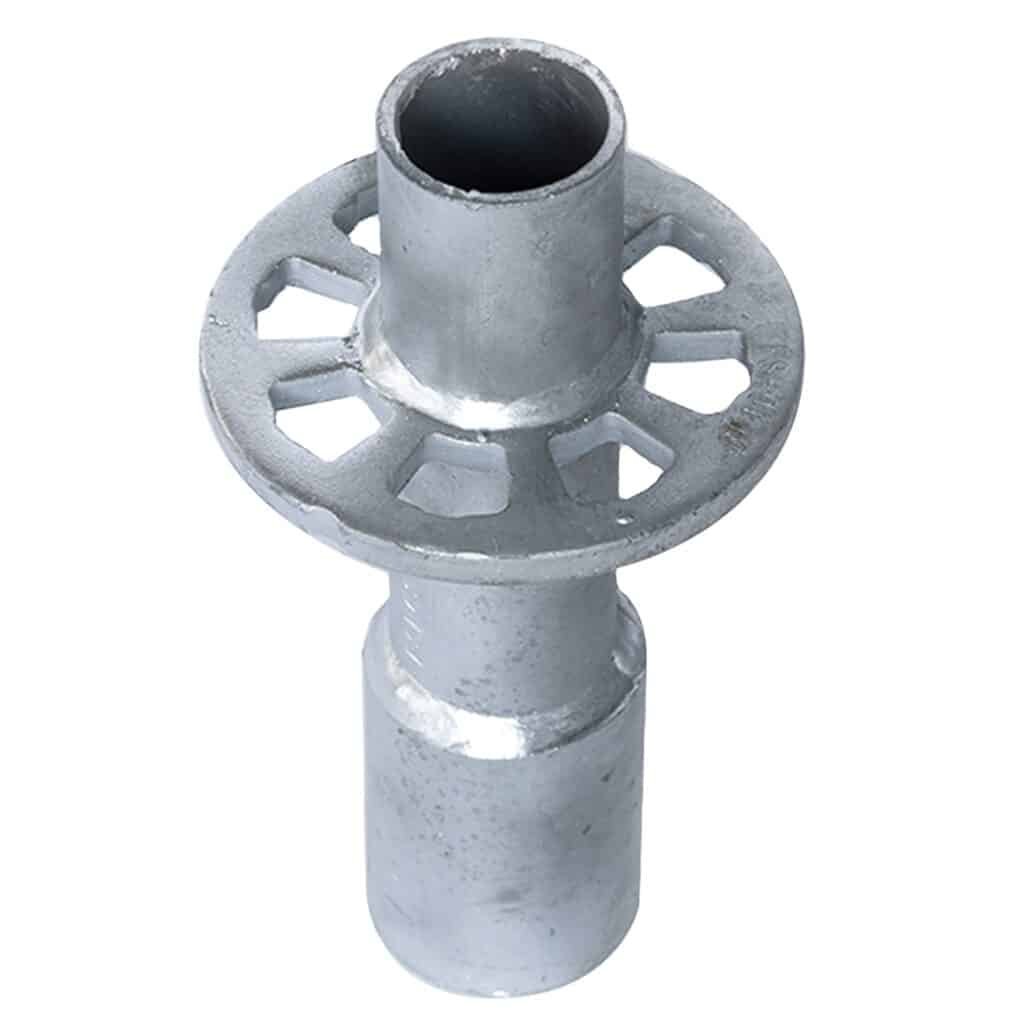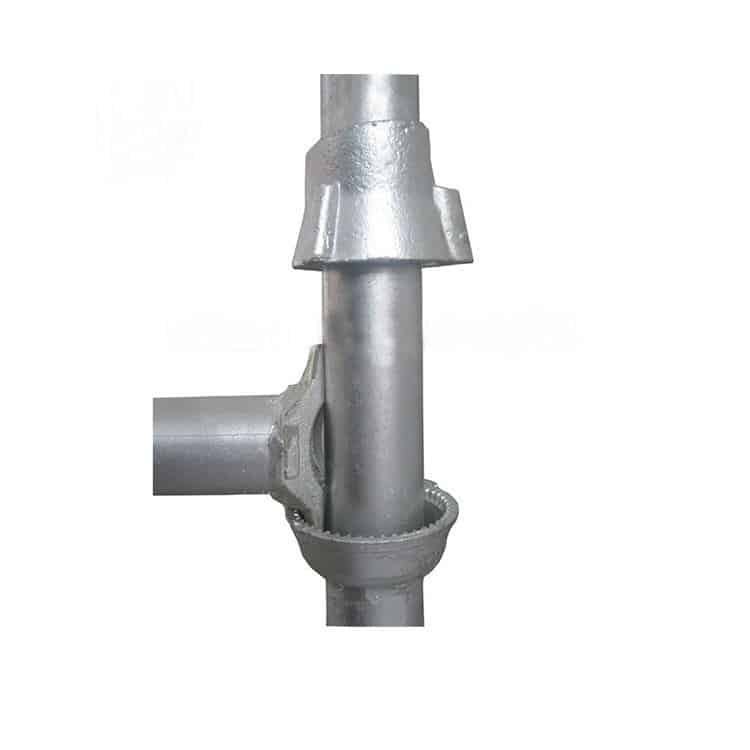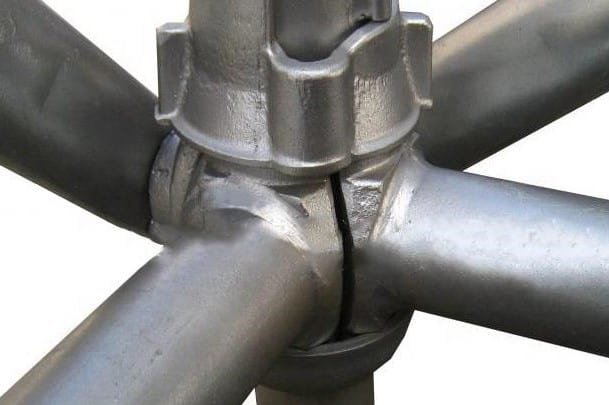Introduction
Scaffolding systems play a crucial role in providing a stable and secure platform for construction activities. Cuplock and Ringlock scaffolding are two popular systems that are widely used in the industry. In this blog, we will delve into the key differences between these two systems. Understanding the differences between Cuplock and Ringlock scaffolding can help you make an informed decision.

What Is Cuplock Scaffolding?
Cuplock scaffolding is a modular scaffolding system widely used in the construction industry for its simplicity, speed, and reliability.
The system consists of vertical standards with cup-like connectors welded at regular intervals. These cups secure joints for horizontal ledgers, creating a robust scaffold structure.
Advantage:
- Quick assembly and disassembly
The wedge-locking mechanism allows for a straightforward and efficient setup, saving valuable time on-site. The system requires fewer components than other scaffolding systems, reducing complexity and potential errors during installation. - High load-bearing capacity
Cuplock scaffolding is renowned for its high load-bearing capacity. The vertical standards, made from high-quality steel, provide excellent strength and stability, making it suitable for heavy-duty applications. The secure cup connections ensure a rigid and secure scaffold structure that can withstand substantial weights and provide a safe working platform for workers. - Simplicity and Versatility
The simplicity and versatility of Cuplock scaffolding make it ideal for a wide range of construction projects. It is commonly used for straight vertical structures such as buildings, bridges, and dams. Its adaptability to different heights and configurations allows for efficient construction progress, especially in projects with tight schedules. - Safety
The secure cup connections minimize the risk of accidental disassembly, ensuring the scaffold remains stable and secure throughout the project. With proper installation and adherence to safety guidelines, Cuplock scaffolding provides construction workers with a reliable and safe working environment.
What Is Ringlock Scaffolding?
Ringlock scaffolding is a versatile and adaptable modular system widely used in the construction industry. It features vertical standards with multiple rosettes or rings welded at various heights. These rosettes serve as connection points for horizontal ledgers, creating a strong and adjustable scaffold structure.
Advantage:
- Flexibility
One of the key advantages of Ringlock scaffolding is its flexibility in height adjustment. The vertical standards allow for easy changes in scaffold levels, accommodating different construction requirements and irregular structures. This adaptability makes Ringlock scaffolding suitable for projects with complex geometries and curved designs. - Superior Stability
Assembly and disassembly are seamless with Ringlock scaffolding. The rosette-based locking system enables quick and secure connections between the standards and ledgers. The locking pins provide stability and prevent accidental disassembly, ensuring a safe working platform for construction personnel. - High Load-bearing Capacity
Ringlock scaffolding is renowned for its exceptional load-bearing capacity. The multiple rosette positions allow for the distribution of heavy loads evenly, providing stability and support for workers and materials. This strength makes Ringlock scaffolding suitable for both small-scale and large-scale construction projects.
Difference between cuplock and ringlock
Are you trying to decide between Cuplock and Ringlock scaffolding for your construction project? Let’s explore the key differences between the two to help you make an informed choice.
Cuplock scaffolding is characterized by vertical standards with cup-like connectors welded regularly. Horizontal ledgers are attached to these cups, creating a secure joint. On the other hand, Ringlock scaffolding features vertical standards with multiple rosettes or rings welded at different heights. Horizontal ledgers are inserted into the rosettes and secured with locking pins.


When it comes to assembly and disassembly, Cuplock scaffolding utilizes a simple and fast wedge-locking mechanism. It requires fewer components, making it quicker to set up and dismantle.
In contrast, Ringlock scaffolding employs a rosette-based locking system, providing flexibility in positioning and adjustable height settings. This versatility allows for various assembly configurations, making it suitable for complex or irregular structures.
In terms of load-bearing capacity, both systems are robust. Cuplock scaffolding has a high load-bearing capacity, which is ideal for heavy-duty applications. However, Ringlock scaffolding surpasses Cuplock in load-bearing capabilities due to its multiple rosette positions, enabling greater flexibility in distributing loads and adapting to different construction requirements.
Application-wise, Cuplock scaffolding is commonly used for straight vertical structures like buildings, bridges, and dams, where speed and simplicity are crucial. Ringlock scaffolding, on the other hand, offers more versatility and adaptability, making it suitable for straight and curved structures and projects with complex geometries and irregular shapes.
Cuplock and Ringlock scaffolding systems provide stability and safety. Cuplock scaffolding’s secure connections and rigid structure offer excellent stability. In contrast, Ringlock scaffolding’s multiple locking points enhance rigidity, reducing the risk of accidental disassembly or collapse.
Consider your project requirements, load-bearing needs, assembly flexibility, and structural complexity when deciding between Cuplock and Ringlock scaffolding. Consulting with a scaffolding professional can help you determine the most suitable system for your project.
Conclusion
Understanding the difference between Cuplock and Ringlock scaffolding is crucial in selecting the right system for your construction project.
Cuplock scaffolding offers simplicity, quick assembly, and high load-bearing capacity, making it ideal for straight structures. On the other hand, Ringlock scaffolding provides versatility, adjustable height settings, superior load-bearing capabilities, and adaptability to complex geometries and curved designs. Both systems offer stability and safety features, ensuring a secure working environment.
Consider your project requirements, load-bearing needs, assembly flexibility, and structural complexity when deciding between Cuplock and Ringlock scaffolding. Consulting with a scaffolding professional can help you determine the most suitable system for your project.







